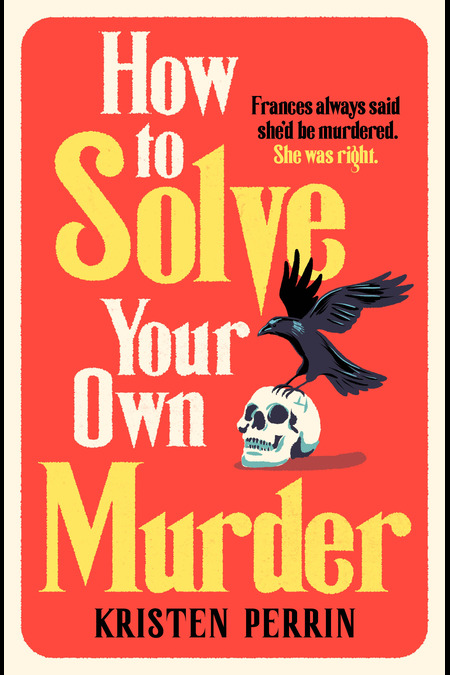Is there anything new under the murder mystery sun?
You may think not; after all, how many ways can you have a crime happen, have it investigated by a quirky though frighteningly competent sleuth and have the killer/s unmasked in suitably dramatic fashion?
As it turns out, quite a lot, fact.
Stuart Turton has proved in his two arrestingly clever novels, The Seven Deaths of Evelyn Hardcastle and The Devil and the Dark Water, that it is possible to take the grand old dame of storytelling genres and be wildly and imaginatively original in the form it takes, and he’s now joined by a number of compelling new writers, among them Kristen Perrin whose debut adult novel, How to Solve Your Own Murder, is proof there’s a lot of life left in the format yet.
The novel comes with an altogether engaging premise – Frances Adams is told in 1965 when she’s a teenager that she will be murdered one day, and while her friends Rose and Emily laugh it off, Frances becomes convinced that she has had her future predicated and death is coming for her much sooner than later.
As she ages, Frances, who ends up quite wealthy and living a privileged life which allows her some idiosyncratic latitude in how she protects herself against what she firmly views as a murderously certain outcome, is ridiculed by friends and family who see her as an irascible, eccentric crackpot whose obsession with death is a fanciful absurdity.
I hear his resonant voice say the word hemlock, but my head swims. I feel faint and unnatural and strange, before my bones melt and an arm pulls me into a chair.
The word hemlock echoes again before everything goes dark.
But then Frances dies.
And as predicted, and as she firmly came to believe, she is murdered, her worst fear coming true; and though she’s in her 80s when it happens, it doesn’t lessen the impact of the fact that a seemingly throwaway line from a fortune teller has come to pass.
But that’s not all the quirky cleverness that How to Solve Your Own Murder has up its sleeve.
Frances posthumously summons various friends and family members to her estate – to be fair, the request comes prior to the actual murder but the timing, inadvertent as it is, is exquisitely on point – and among them is her great-niece Annie who finds herself thrown into a hothouse atmosphere in the small town of Castle Knoll where Frances grew up and lived, not always happily.
While this might be par for the course in murder mysteries to have an eclectic group pulled together, the better to cast an involved and red herring-rich investigation, the way in which How to Solve Your Own Murder uses them is truly inventive.
For the people who come to Frances’ home after she is found dead – again, everyone expects her to be there alive but then fate has other ideas – are told they must solve the murder, and if they succeed, they will inherit Frances’ impressive estate, properties and a considerable, life-changing sum of money.
It’s a mind boggling idea and one that initially throws Annie who, nonetheless, rises to the occasion, not so much for the money but to get to know the great-aunt she barely knew and to bring justice to someone sorely in need of it.
(courtesy Goodreads)
What makes How to Solve Your Own Murder such a substantial delight to read is that, creative premise aside, Perrin successfully adds some truly weighty humanity into proceedings.
Her characters, whether main or supporting players, are all richly and fully realised, with the book divided between present events and a recounting of a past rife with all kinds of betrayal, loss and dark happenings, all of them informing in some way or another, what Annie undergoes in the mother of all inheritance processes.
It would be easy to have one period of time overwhelm the other but in Perrin’s assured hands, the two inform each other perfectly, adding to a narrative that feels weighty and substantial, capable of being far more than just a vehicle for some nifty murder mystery shenanigans.
As a result, there’s almost nothing formulaic or run of the mill about How to Solve Your Own Murder which bubbles away with some real wit and humour, and even a mild case of the diverting rom-coms but most importantly with a real and palpable sense that here are real people caught up in what almost feels like an unreal situation.
Thus, we get the murder mystery investigation and reveal we all love and crave, and the sense of justice served that that provides, but with some real emotional impact flowing through and out of it too.
I try the handle, ready to burst back out into the hall, but it won’t budge. I look across the room to the bedside cabinet, and swear inwardly. The little skeleton key that unlocks the door is right there, next to the wardrobe, from where a second thud sounds.
There’s someone in here with me, and I’ve locked us both in.
That ability to fold in some weight emotional impact seems to be a hallmark of many modern murder mysteries.
They might well be cosy or quirky and have a sense of certain trope boxes being ticked, albeit with breathtaking and fun originality, but they also carry a real sense of what events like this would do to a person.
Heightened, of course, for full narrative clout and to allow for fictional freedom, but nevertheless, real enough that you feel as if there is a crushing authenticity to the story, something Perrin absolutely and decisively delivers.
It’s tough to meld the tried and tried hallmarks of murder mystery fiction with some post-modern humanist knowingness, but How to Solve Your Own Murder manages it with highly engaging aplomb, its dialogue shark sharp and clever, its characters a considerable beyond being cardboard cutout territory, and its story as apt to take a deep dive into the cold and cruel things people, even those who love each other, can perpetrate, as to take another step closer to solving the burbling mystery to hand.
How to Solve Your Own Murder is pleasingly and happily brilliant, a thoroughly inspired and magnificently imaginative story that delivers on what the murder mystery genre promises while serving up some real, often, moving drama that elevates the story far above Midsomer Murders territory and into a place that delivers weight and emotional gravitas to its fantastically well-realised and never-less-than utterly satisfying whodunnit.

